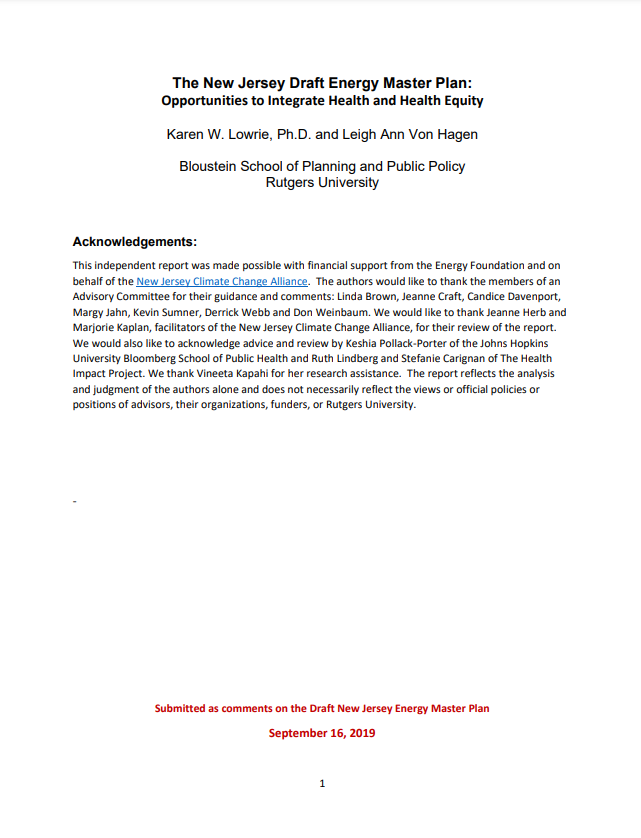Economic, environmental and societal forces contribute substantially to our health – as much as, studies show, or more than genetics, individual behavior and access to healthcare. Examples of these Social Determinants of Health include quality of housing and schools, access to healthy foods, living-wage jobs, transportation mobility, environmental exposures to pollution and other hazards, availability of social support networks and community safety.
The New Jersey Energy Master Plan (EMP) “is intended to set forth a strategic vision for the production, distribution, consumption, and conservation of energy in the State of New Jersey.” Energy, too, is an important social determinant of health including its source, generation, transmission and delivery, mode of use, cost, and associated wastes and emissions. Whether used for home heating and cooling, cooking, transportation, industrial and commercial operations or other purposes, energy can be an important contributor, positively or negatively, to individual and community health. The contribution of energy systems to health can be direct, such as through environmental exposures to emissions from energy generation, or indirect, such as may be the case for certain populations that pay disproportionate amounts for energy bills which, in turn, may affect the availability of resources to support healthy living such as food, quality housing and healthcare (US DOE, 2018).
Rutgers scholars have been at the forefront of promoting Health in All Policies (HiAP) as a collaborative approach to reducing disparities and improving the health of all communities and people by incorporating health considerations into decision-making across sectors and policy areas. Given the limited time available in the review period of the draft Energy Master Plan and its high level nature, the authors have not conducted a comprehensive assessment of all health and health equity implications of the EMP and its implementation. To do so would require many months of data gathering and detailed analysis.
Instead, as part of our continuing HiAP efforts in New Jersey, we prepared a set of insights on opportunities to integrate health considerations into the EMP, based in part on collective knowledge in the health impact and health equity fields, and in part on a literature review conducted on prioritized portions of the EMP. The report offers a “health lens” through which to view some of the potential impacts of implementing elements of the EMP. This analysis focuses on health equity, or the concept of equitable access to conditions and resources that allows one to live the healthiest life possible. It pays strong attention to impacts on populations and communities that may already suffer disproportionate health, social, environmental, and economic inequities, which may be exacerbated by a proposed decision. Thus, this evaluation is in effect a public health prevention model intended to help to prevent potentially unanticipated negative outcomes and costs, and to provide guidance on policy decisions that will improve health and reduce disparities.
The report includes the following two main sections:
- LITERATURE REVIEW: PROJECTED HEALTH IMPACTS OF SELECTED EMP COMPONENTS – Describes a rapid review of recent scientific and public health literature conducted on selected strategies within the EMP, including generalized findings supported by the literature. Some of these suggest areas where additional research is needed.
- INCORPORATING HEALTH AND HEALTH EQUITY INTO ENERGY PLANNING AND IMPLEMENTATION – Presents a set of overall insights for consideration in preparation of the final EMP on subjects for which there is a clear connection to health or health equity. Insights derived from the literature on selected priority areas are also included.
